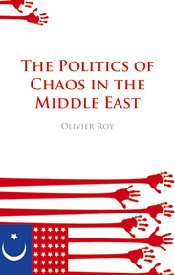|
Reviewed by Lewis Brownstein, Ph.D., Professor of International Relations, State University of New York-New Paltz, New Paltz, NY. There is a very real need for a good introduction to the international relations of the Middle East. Unfortunately, Oliver Roy’s The Politics of Chaos in the Middle East is not it. Roy has written a disorganized, internally contradictory and derivative book which essentially consists of his musings on a number of salient issues in an area which he loosely refers to as the Middle East. I say loosely because his focus stretches from Morocco to Pakistan and he uses the terms Middle East and Near East interchangeably. The major weakness of this book is its lack of coherent focus. It is unclear whether the author wishes to discuss state-to-state relations, communal conflicts, or ideological divisions. Time and again he makes sweeping generalizations for which he offers virtually no evidence. For example, he is clearly very critical of the policies of the Bush Administration in the region, especially the invasion of Iraq, while adding little to the debate. Instead of adding scholastic insights on the Bush Administration’s Middle East policy, his discussion focuses on what he understands to be the influence of the “neo-conservatives” and is replete with unsubstantiated generalizations which consist of little more than his opinions presented without evidence. Again and again Roy sets up a straw man—based on an assertion which he offers—and then takes issue with his own construct. There are many examples of this throughout the text, but two cases in particular are worth highlighting. On pp. 39-40 the following sentence appears: “It was thought that within two or three years, the Afghan and Iraqi peoples would establish viable democracies and robust institutions.” The passage then continues with a supposed set of expectations the Bush people were alleged to have had. No evidence is presented or examples given. Or, on page 63 one finds the assertion that “Sharia” is often spoken of as the expression of an Islamic totalitarianism.” He then proceeds to attack the assertion, but no context is given. One can find numerous examples of this approach in Roy’s book. Roy’s discussions of terrorism, Islamist movements, and the relationship between Islamic and other forms of identity and the fundamental causes of regional conflict are likewise internally inconsistent and lacking in coherence. Thus, he refers to a “deterritorialised and decultured” “neofundamentalism” and lumps the Afghan Taliban, Al Qaeda the Saudi Wahhabis, the Salafists and the Tabligh Movement all together. (p.58) He variously refers to terrorism as a tactic and a movement, in different parts of the book. In the beginning of the book he implies that the problems of the region are caused by the Bush policies and later suggests that they are internally derived. The reader is left confused as to the essence of his analysis. There are a few sections of the book which are worth noting. His discussion of the three traumas of the Arab Middle East, his discussion of the schism between Sunni and Shia, especially some of his observations on Iran, or some of his comments on Al Qaeda at the end of the book come to mind. Unfortunately, they tend to be derivative, based for the most part on other scholarship. While there is nothing wrong with this, these passages do not represent new insights or original research. Aside from a few footnotes there are no citations of note and no bibliography. Those insights worth gleaning must be sought out by reading through the entire book. In the final analysis, the reader is probably better off devoting that time to other—more thorough—offerings that contain new scholarship on Middle East politics than you will find in this title. |


 The Politics of Chaos in the Middle East
The Politics of Chaos in the Middle East